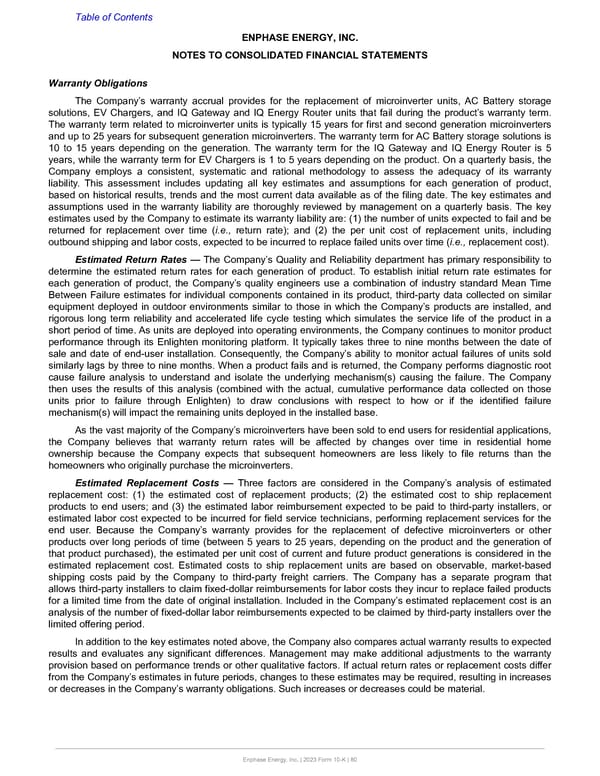Table of Contents ENPHASE ENERGY, INC. NOTES TO CONSOLIDATED FINANCIAL STATEMENTS Warranty Obligations The Company’s warranty accrual provides for the replacement of microinverter units, AC Battery storage solutions, EV Chargers, and IQ Gateway and IQ Energy Router units that fail during the product’s warranty term. The warranty term related to microinverter units is typically 15 years for first and second generation microinverters and up to 25 years for subsequent generation microinverters. The warranty term for AC Battery storage solutions is 10 to 15 years depending on the generation. The warranty term for the IQ Gateway and IQ Energy Router is 5 years, while the warranty term for EV Chargers is 1 to 5 years depending on the product. On a quarterly basis, the Company employs a consistent, systematic and rational methodology to assess the adequacy of its warranty liability. This assessment includes updating all key estimates and assumptions for each generation of product, based on historical results, trends and the most current data available as of the filing date. The key estimates and assumptions used in the warranty liability are thoroughly reviewed by management on a quarterly basis. The key estimates used by the Company to estimate its warranty liability are: (1) the number of units expected to fail and be returned for replacement over time (i.e., return rate); and (2) the per unit cost of replacement units, including outbound shipping and labor costs, expected to be incurred to replace failed units over time (i.e., replacement cost). Estimated Return Rates — The Company’s Quality and Reliability department has primary responsibility to determine the estimated return rates for each generation of product. To establish initial return rate estimates for each generation of product, the Company’s quality engineers use a combination of industry standard Mean Time Between Failure estimates for individual components contained in its product, third-party data collected on similar equipment deployed in outdoor environments similar to those in which the Company’s products are installed, and rigorous long term reliability and accelerated life cycle testing which simulates the service life of the product in a short period of time. As units are deployed into operating environments, the Company continues to monitor product performance through its Enlighten monitoring platform. It typically takes three to nine months between the date of sale and date of end-user installation. Consequently, the Company’s ability to monitor actual failures of units sold similarly lags by three to nine months. When a product fails and is returned, the Company performs diagnostic root cause failure analysis to understand and isolate the underlying mechanism(s) causing the failure. The Company then uses the results of this analysis (combined with the actual, cumulative performance data collected on those units prior to failure through Enlighten) to draw conclusions with respect to how or if the identified failure mechanism(s) will impact the remaining units deployed in the installed base. As the vast majority of the Company’s microinverters have been sold to end users for residential applications, the Company believes that warranty return rates will be affected by changes over time in residential home ownership because the Company expects that subsequent homeowners are less likely to file returns than the homeowners who originally purchase the microinverters. Estimated Replacement Costs — Three factors are considered in the Company’s analysis of estimated replacement cost: (1) the estimated cost of replacement products; (2) the estimated cost to ship replacement products to end users; and (3) the estimated labor reimbursement expected to be paid to third-party installers, or estimated labor cost expected to be incurred for field service technicians, performing replacement services for the end user. Because the Company’s warranty provides for the replacement of defective microinverters or other products over long periods of time (between 5 years to 25 years, depending on the product and the generation of that product purchased), the estimated per unit cost of current and future product generations is considered in the estimated replacement cost. Estimated costs to ship replacement units are based on observable, market-based shipping costs paid by the Company to third-party freight carriers. The Company has a separate program that allows third-party installers to claim fixed-dollar reimbursements for labor costs they incur to replace failed products for a limited time from the date of original installation. Included in the Company’s estimated replacement cost is an analysis of the number of fixed-dollar labor reimbursements expected to be claimed by third-party installers over the limited offering period. In addition to the key estimates noted above, the Company also compares actual warranty results to expected results and evaluates any significant differences. Management may make additional adjustments to the warranty provision based on performance trends or other qualitative factors. If actual return rates or replacement costs differ from the Company’s estimates in future periods, changes to these estimates may be required, resulting in increases or decreases in the Company’s warranty obligations. Such increases or decreases could be material. Enphase Energy, Inc. | 2023 Form 10-K | 80
 Annual Report Page 79 Page 81
Annual Report Page 79 Page 81